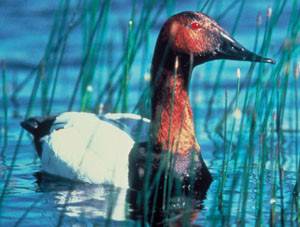 Aythya is Latin for a generic seabird or duck; valisineria comes from the Italian botanist Antonio Vallisnieri. He was honored by other scientists, who applied his name to a genus of aquatic plants, including the wild celery; when ornithologists discovered that Canvasbacks have a preference for plants in the genus, the name was transferred to the bird, as well.
Aythya is Latin for a generic seabird or duck; valisineria comes from the Italian botanist Antonio Vallisnieri. He was honored by other scientists, who applied his name to a genus of aquatic plants, including the wild celery; when ornithologists discovered that Canvasbacks have a preference for plants in the genus, the name was transferred to the bird, as well.
Indeed, although omnivorous, Canvasbacks feed primarily on wild celery during the non-breeding season, along with other roots, buds, and tubers, as well as invertebrates. They feed on these benthic foods, found on the bottom of lakes or rivers, by diving up to 30 feet deep. They are specially adapted to forage in the benthic microhabitat: their long, sloping, powerful bills can probe into mud and rip apart plant tubers, and their use of a vertical dive and buoyant, energy-efficient float to the surface minimizes wasteful horizontal movement away from the richest underwater feeding grounds.
Canvasbacks are large, graceful diving ducks, with a glowing white back (canvas white, in fact), a ruddy head, a black chest, and a black tail. Although they are patterned similarly to Redhead ducks, Canvasbacks have a distinctively shaped bill, which has a smooth, gently sloping transition to the head, making the entire head appear elongated. Redheads are smaller, have a more abrupt transition between head and bill, and have dusky backs rather than white backs.
Canvasbacks breed in the interior of the continent, from Minnesota to Alaska and west to Oregon. They prefer breeding in sheltered lakes, ponds, and marshes. After breeding, they form flocks and concentrate in open water along coastlines and interior lakes, particularly between Utah and Tennessee. Winter flocks in the Atlantic can be more than 1,000 birds strong; other flocks incorporate other species of Aythya diving ducks, including Redhead, Greater Scaup, Lesser Scaup, and Ring-necked Duck. During migration, Canvasbacks are found in smaller flocks. Along the Portage Lake Chain of Lakes, Canvasbacks are winter residents and migrants in small numbers. They typically arrive in early November, departing as late as April, with flocks of 1-25 individuals. They cluster with other ducks on open water, such as on Portage Lake; if the water freezes over, they will fly further south to the nearest available open water.
Canvasbacks have a range of calls, primarily a soft cooing; only ducks related to Mallards give the characteristic “quack” sound of a duck. During courtship, males softly murmur while throwing back their heads, repeatedly bending and stretching their neck. Courtship and pair bonding take place during spring migration and early on the breeding grounds. After they migrate back north, Canvasbacks nest along the shores of quiet, secluded lakes, building a floating, semi-aquatic nest of plant debris inside dense vegetation of rushes, sedges, or cattails. In mid-April, most individuals lay 7-8 eggs, but egg parasitism is rampant among Canvasbacks and their relatives, Redheads. Some Redheads and Canvasbacks will lay their eggs in other individuals’ nests, to be cared for by the adoptive parent Canvasback or Redhead. Parasitized nests typically had three intruder eggs, but nest parasites remove one normal egg to make up for the additional intruding egg, so the overall clutch size remains the same.
Further Reading
Click Here for information from All About Birds
Click Here for information from ARKive
Click Here for information from Birds of North America
Click Here for information on Canvasback calls
Click Here for information from Ducks Unlimited
Click Here for eBird sightings of Canvasbacks
Click Here for a feeding frenzy video with other ducks
Click Here for a high-quality video of a male Canvasback:
Click Here for information from the Minnesota DNR